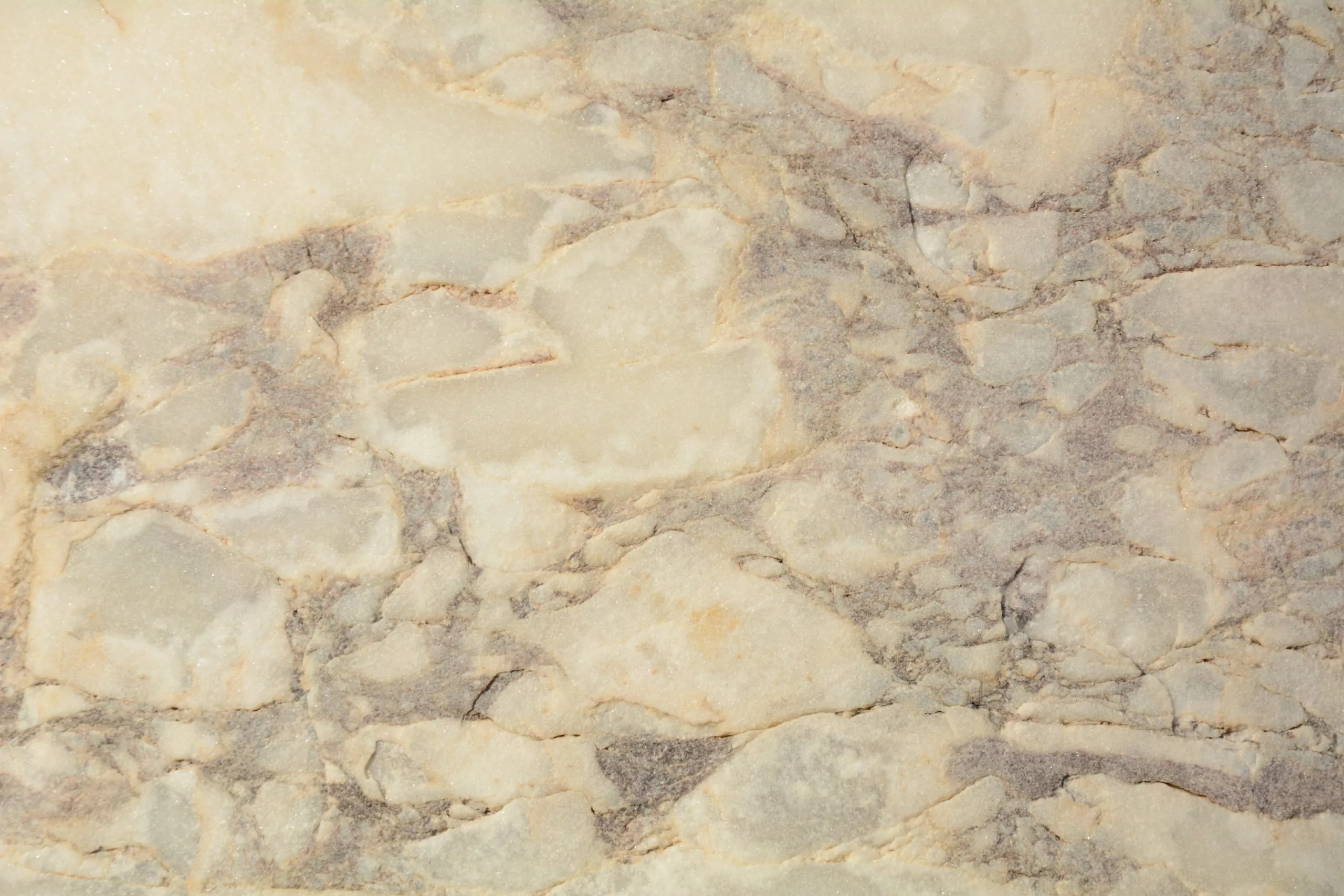Marble is a natural stone that has been used for centuries as a building material and decorative element. Its elegant and timeless beauty makes it a popular choice for countertops, flooring, and other applications. But have you ever wondered how marble is made?
In this article, we will take you through the process of how marble is formed and turned into the stunning slabs used in homes and buildings.
What Is Marble Made From?
Marble is a metamorphic rock that forms when limestone is exposed to high heat and pressure. This process changes the composition, forming predominantly calcite or dolomite crystals, giving marble its distinct textures and patterns. It is available in a wide array of colors, including white, black, green, gray, yellow, and rose, depending on the mineral impurities present during its formation.
It’s known for its characteristic veining patterns and a high-polish finished surface, which contributes to its luxury and grandeur. Interestingly, each slab of marble is unique, reflecting its distinct geological footprint. It is treasured for its beauty and is often used in architecture and design, especially for countertops, flooring, and sculptures.
How Is Marble Created?
Marble is created through a natural process known as metamorphism, which occurs deep within the Earth’s crust. This starts when limestone or dolomite, stones primarily composed of calcite, face extreme heat and pressure beneath the Earth’s surface. The high temperatures and crushing pressure cause the limestone to recrystallize, transforming it into the denser, beautiful stone that we know as marble.
In this transformative process, any impurities within the original limestone or surrounding sediment and minerals will often react to form different colors, patterns, or veining in the marble.
For instance, clay minerals, iron oxides, and silicate minerals present in the limestone can result in beautiful hues of red, green, black, blue, or brown. The unique swirls, veins, and specks found in marble slabs result from mineral impurities present during the metamorphism process.

What Are the Different Types of Marble?
1. Carrara
Carrara marble is one of the most popular types of marble and is often used in interior design and architectural projects. It is distinguished by its white or light gray color with subtle veining that can be linear or feathery. Named after the city of Carrara in Italy, where it’s quarried, this marble has been used in some of the world’s most iconic buildings and sculptures, including the Pantheon and Michelangelo’s David.
2. Statuario
Statuario marble is considered one of the most precious marble and is also quarried in Italy. Similar to Carrara marble in its white background, Statuario sets itself apart by possessing distinct, bold veining patterns in gray or glistening gold. Due to its distinctive, luxurious appeal and rarity, it is often used in high-end projects or as a striking accent in interior design.
3. Calacatta
Calacatta marble is characterized by its pure white background and bold, large-scale veining, which can range in color from gold to gray. Originating in Italy, Calacatta is named after the city where it is quarried. This particular type of marble is often associated with luxury due to its rare occurrence and its bold and dramatic veining, making it a coveted choice for high-end residential and commercial design projects.
4. Emperador
Emperador Marble is noted for its deep, rich brown color, almost resembling a fine mahogany wood grain. Native to Spain, this unique marble variant is renowned for its intricate veining, typically in hues of white and light brown, which add depth and character to its dark background. Though it comes in several different shades, the most popular version is often the dark brown variant, offering an attractive contrast when paired with lighter materials.
5. Crema Marfil
Crema Marfil is a distinctive type of marble that originates from Spain. It is famous for its warm, creamy beige tone with neutral veining that can range from subtle to quite extensive. The natural color variation and classic elegance of Crema Marfil make it a preferred choice for those aiming for a more subtle luxury, often used in flooring, countertops, and wall accents to bring warmth and a sense of sophistication.
Marble Vs. Other Rocks?
Marble is often confused with other types of rocks, such as granite and quartzite. While they may have similar appearances, marble has distinct characteristics that set it apart.
Here are the key differences:
Composition and Formation
Unlike other rocks, marble originates from limestone or dolomite, which undergoes a process of metamorphism under intense heat and pressure deep within the earth’s crust. This process results in the recrystallization of the original carbonate mineral grains, giving marble its unique veined appearance and texture.
Colors and Patterns
Marble is known for its luxurious veining patterns and wide range of colors, a characteristic that sets it apart from other rocks. The impurities present in the original limestone or its surrounding environment influence the color and pattern variations of marble.
Use and Application
Marble is commonly used in architecture and design, specifically in high-end construction projects and sculptures, due to its beauty and polish. It’s less common in other rocks to share these applications, as they may not have marble’s level of refinement and aesthetic appeal.
Durability
While other rocks like granite and quartzite are considered harder and more resistant to scratches, marble ages with a unique charm, developing a light surface texturing referred to as a patina. This quality enhances the stone’s aesthetic value and does not compromise its structural integrity.
Why Is This Natural Stone Great for Countertops?
Appearance
Marble countertops are admired for their elegant and luxurious look. The unique patterns and veining of marble, along with its high-gloss finish, create a glamorous and polished aesthetic, upgrading the overall design of any kitchen or bathroom.
Heat Resistance
One of the properties that make marble a preferred choice for kitchen countertops is its high resistance to heat. This attribute makes it perfect for continuous use in the kitchen, like placing hot pots directly on the countertop without the risk of causing damage.
Unique Qualities
Each slab of marble is one-of-a-kind, with distinct veining and color variations, making your countertop a unique piece of art. This ensures that no two marble countertops are alike, giving your space a personalized feel.
Increased Home Value
Installing marble countertops can significantly increase the value of your home due to its luxurious appeal and enduring style. They are often a key selling point for potential homebuyers who are willing to pay for quality and elegance.
Durability
Despite being a soft stone, marble is a durable material that can last for decades with proper care and maintenance. It tends to develop a beautiful patina over time, which can add a classic charm to any space.
How Are Marble Countertops Made?
Step 1: Extraction
The first step in answering “how do you make marble countertops?” is to extract large marble blocks from quarries. This process entails the use of modern cutting and mining techniques. These blocks can weigh several tons each and are carefully selected based on their quality and suitability for countertops.
Step 2: Cutting and Shaping
Once extracted, the blocks are transported to fabrication facilities and cut into slabs of various thicknesses. Skilled artisans use advanced machinery to shape the slabs according to the desired dimensions and specifications.
Step 3: Polishing
The slabs undergo a polishing process to achieve the signature smooth and glossy finish of marble countertops. This involves grinding the surface with progressively finer abrasives until it attains a mirror-like shine. Polishing also enhances the natural veining and patterns of the marble, adding depth and character to the finished product.
Step 4: Sealing
Marble is a porous stone that can be susceptible to staining and etching if improperly sealed. Before installation, the countertops are treated with a high-quality sealant that helps protect against moisture, spills, and other potential damage.
Step 5: Installation
Once the fabrication process is complete, the marble countertops are carefully transported to the installation site. Experienced professionals ensure precise fitting and secure installation, guaranteeing a seamless and long-lasting result.
Add a Touch of Luxury to Your Home With Real Marble Countertops from LGS Granite
Whether you opt for real marble or explore cultured marble options, a wide range of choices are available to suit your preferences and needs. The versatility and elegance of marble make it a classic and luxurious addition to any space. So, if you’re looking for a durable, beautiful, and sophisticated countertop material, consider marble’s timeless beauty.
Remember, when choosing marble countertops or any natural stone, consult with experts and reputable suppliers to ensure you make an informed decision. Embrace the allure of real marble and elevate your space with this exceptional and captivating material.
Ready to transform your space with the beauty of marble? Contact LGS Granite today to explore our wide range of natural marble countertops and discover the elegance and sophistication that this classic material can bring to your home or business.


